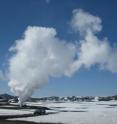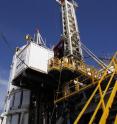Geologists get unique and unexpected opportunity to study magma
Geologists drilling an exploratory geothermal well in 2009 in the Krafla volcano in Iceland encountered a problem they were simply unprepared for: magma (molten rock or lava underground) which flowed unexpectedly into the well at 2.1 kilometers (6,900 ft) depth, forcing the researchers to terminate the drilling. "To the best of our knowledge, only one previous instance of magma flowing into a geothermal well while drilling has been documented," said Wilfred Elders, a professor emeritus of geology in the Department of Earth Sciences at the University of California, Riverside, who led the research team. "We were drilling a well that was designed to search for very deep – 4.5 kilometers (15,000 feet) – geothermal resources in the volcano. While the magma flow interrupted our project, it gave us a unique opportunity to study the magma and test a very hot geothermal system as an energy source."
Currently, a third of the electric power and 95 percent of home heating in Iceland is produced from steam and hot water that occurs naturally in volcanic rocks.
"The economics of generating electric power from such geothermal steam improves the higher its temperature and pressure," Elders explained. "As you drill deeper into a hot zone the temperature and pressure rise, so it should be possible to reach an environment where a denser fluid with very high heat content, but also with unusually low viscosity occurs, so-called 'supercritical water.' Although such supercritical water is used in large coal-fired electric power plants, no one had tried to use supercritical water that should occur naturally in the deeper zones of geothermal areas."
Elders and colleagues report in the March issue of Geology (the research paper was published online on Feb. 3) that although the Krafla volcano, like all other volcanoes in Iceland, is basaltic (a volcanic rock containing 45-50 percent silica), the magma they encountered is a rhyolite (a volcanic rock containing 65-70 percent silica).
"Our analyses show that this magma formed by partial melting of certain basalts within the Krafla volcano," Elders said. "The occurrence of minor amounts of rhyolite in some basalt volcanoes has always been something of a puzzle. It had been inferred that some unknown process in the source area of magmas, in the mantle deep below the crust of the Earth, allows some silica-rich rhyolite melt to form in addition to the dominant silica-poor basalt magma."
Elders explained that in geothermal systems water reacts with and alters the composition of the rocks, a process termed "hydrothermal alteration." "Our research shows that the rhyolite formed when a mantle-derived basaltic magma encountered hydrothermally altered basalt, and partially melted and assimilated that rock," he said.
Elders and his team studied the well within the Krafla caldera as part of the Iceland Deep Drilling Project, an industry-government consortium, to test whether geothermal fluids at supercritical pressures and temperatures could be exploited as sources of power. Elders's research team received support of $3.5 million from the National Science Foundation and $1.5 million from the International Continental Scientific Drilling Program.
In the spring of 2009 Elders and his colleagues progressed normally with drilling the well to 2 kilometers (6,600 feet) depth. In the next 100 meters (330 feet), however, multiple acute drilling problems occurred. In June 2009, the drillers determined that at 2104 meters (6,900 feet) depth, the rate of penetration suddenly increased and the torque on the drilling assembly increased, halting its rotation. When the drill string was pulled up more than 10 meters (33 feet) and lowered again, the drill bit became stuck at 2095 meters (6,875 feet). An intrusion of magma had filled the lowest 9 meters (30 feet) of the open borehole. The team terminated the drilling and completed the hole as a production well.
"When the well was tested, high pressure dry steam flowed to the surface with a temperature of 400 Celsius or 750 Fahrenheit, coming from a depth shallower than the magma," Elders said. "We estimated that this steam could generate 25 megawatts of electricity if passed through a suitable turbine, which is enough electricity to power 25,000 to 30,000 homes. What makes this well an attractive source of energy is that typical high-temperature geothermal wells produce only 5 to 8 megawatts of electricity from 300 Celsius or 570 Fahrenheit wet steam."
Elders believes it should be possible to find reasonably shallow bodies of magma, elsewhere in Iceland and the world, wherever young volcanic rocks occur.
"In the future these could become attractive sources of high-grade energy," said Elders, who got involved in the project in 2000 when a group of Icelandic engineers and scientists invited him to join them to explore concepts of developing geothermal energy.
The Iceland Deep Drilling Project has not abandoned the search for supercritical geothermal resources. The project plans to drill a second deep hole in southwest Iceland in 2013.
Source: University of California - Riverside
Articles on the same topic
- Magma power for geothermal energy?Thu, 17 Feb 2011, 20:04:03 UTC
Other sources
- Volcanic magma could be power sourcefrom UPIThu, 17 Feb 2011, 22:50:35 UTC
- Magma power for geothermal energy?from PhysorgThu, 17 Feb 2011, 20:20:39 UTC
- Magma power for geothermal energy?from Science BlogThu, 17 Feb 2011, 20:20:15 UTC
- Iceland volcano drilling suggests magma could become source of high-grade energyfrom Science DailyWed, 16 Feb 2011, 23:30:15 UTC
- Geologists get unique and unexpected opportunity to study magmafrom PhysorgWed, 16 Feb 2011, 17:30:49 UTC
- Geologists get unique and unexpected opportunity to study magmafrom Science BlogWed, 16 Feb 2011, 17:03:14 UTC


